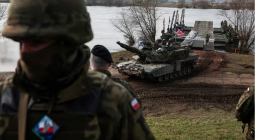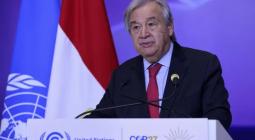NATO Report Outlines Growing Climate Risks to Global Security
Last week, world leaders from more than 30 countries across North America and Europe gathered in Washington to discuss the top security threats facing members of NATO, the North Atlantic Treaty Organization.
During the summit, NATO released a report outlining the accelerating threats emerging from a top foe: climate change. Part of a broader climate action strategy, the assessment examines the many ways climate impacts—from heat waves to ocean acidification—affect security infrastructure, military personnel, NATO adversaries and disaster response.
The Human Impacts: Often some of the first on the scene after a disaster, NATO military personnel are uniquely at risk to climate extremes, the report finds. Last year, nearly 30 international military deployments responded to climate-related emergencies in 14 countries, including Slovenia and Greece.
In the U.S., more than 600 military personnel were sent to help manage the wildfires that ripped through Hawaii in 2023, marking one of the largest deployments in response to a single hazard in the country’s recent history.
On a daily basis, soldiers are regularly exposed to harsh conditions such as dust storms, intense rain and droughts, all expected to get worse as climate change accelerates. According to the report, recent years have brought more “black flag weather days,” during which operations in NATO areas must be limited or halted to avoid health risks because temperatures exceed 95 degrees Fahrenheit.
“Looking ahead, Allied military forces will be required to adapt to hotter temperatures and increasingly more challenging, extreme and unpredictable operating environments, as well as to prepare for an increasing demand to assist civilian authorities when disasters strike,” the report reads.
These types of conditions can also fuel human conflict, according to Jason Bordoff, the founding director of the Center on Global Energy Policy at Columbia University.
“Climate change exacerbates resource scarcity, leading to conflicts over water and food,” he told me over email. “It can also impact large-scale migrations, which can destabilize regions and strain national security, leading to humanitarian crises and increased pressure on receiving countries’ resources and infrastructure.”
The NATO report points to the Arctic, where melting sea ice and dwindling fish stocks could result in greater competition and human activity in new places. That would create logistical challenges for security monitoring.
Crumbling Infrastructure: The report finds that extreme weather is also wreaking havoc on NATO members’ military equipment and infrastructure in each of their operating domains.
On land, fire can pose complex tactical challenges for military operations; for example, the July 2023 wildfire in Greece spread onto a nearby ammunition depot and set off a series of explosions, The Associated Press reported. Places near the Arctic face dual threats from fire and thawing permafrost, which can destabilize military bases built on the frozen soil, such as Eielson Air Force Base in Fairbanks, Alaska. This thaw could also unearth Cold War era military waste sites in Alaska, Greenland and Russia, which could leach into the surrounding environment and harm local people and wildlife, ABC News reports.
At sea, climate change is altering the ocean’s chemistry, which could impact the use of sonar in submarine operations, according to the report. A recent study revealed that in some areas, sonar detection range is contracting due to rising ocean temperatures and ocean acidification caused by climate change, potentially hampering the ability to track enemy submarines at long distances in key NATO geographic regions. In the sky, warmer temperatures are thinning out the air, which makes it more difficult for naval helicopters to take off and decreases the amount of mass a cargo load can carry.
The report also highlights the intertwined climate and security risks popping up in a more recently established domain: the virtual world. Extreme weather regularly disrupts telecommunications networks that are crucial during disaster-response operations, such as in Houston, where Hurricane Beryl recently knocked out power for nearly 3 million people. (My colleague Dylan Baddour recently wrote about why this storm showed how vulnerable the nation’s energy capital remains, if you’d like to read more.)
Cyber risks are also emerging in the form of vast climate disinformation campaigns. For example, Russia—a current NATO adversary and big oil and gas exporter—was found to be one of the main drivers of online disinformation surrounding the green energy transition from 2022 to 2024, according to the report.
“The dysfunction stemming from climate denial and misinformation can pose a huge risk to actually advancing climate goals and climate action globally,” Bordoff said.
How NATO Addresses Climate Risks: At the recent NATO summit, a number of world leaders stressed the urgency of tackling climate change to protect security.
“Overall, climate change risks creating a less stable, less prosperous and less secure world,” Canadian Prime Minister Justin Trudeau said.
However, some experts are critical of NATO’s large carbon footprint from military activities, which fuel some of the climate extremes it is currently contending with. Research released last week revealed that NATO’s 2023 military budget supported activities that released around 233 million metric tons of carbon.
In 2021, Allied forces established the “Climate and Security Action Plan,” a strategy to help integrate climate considerations into Allied countries’ political and military agendas, including methods to reduce emissions from military activities. NATO training exercises now include climate scenarios to prepare forces for operations in extreme conditions. Some countries, including the U.S., are developing new, more breathable combat uniforms to help soldiers avoid heat stress.
To address infrastructure threats, “the U.S. and others are also actively making bases more resilient against rising sea-levels, flooding, and storm surges by raising piers and docks, improving drainage systems, fortifying buildings, and retrofitting critical infrastructure,” Bordoff told me.
“The NATO climate impact assessment shows that climate security threats are not just in the most vulnerable places globally, but also serious threats to the homeland that Allies are mobilizing to address.”





